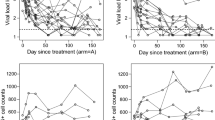Abstract
Motivated by an example we discuss the problem of comparison to control in a scenario where we have repeated binary data from a large number independent individuals under each comparison group. We use the generalized quasi-likelihood (GQL) estimators for the comparison group effects including the effect of the control group to define a single step and step-down method for performing many-to-one comparisons. We discuss the asymptotic properties of our method and provide ways of computing the critical values. We follow up with simulations for Type I error and marginal power and show that our proposed method performs well in practice.
Similar content being viewed by others
References
Chuang-Stein, C. and Tong, D. (1995). Multiple comparisons with control based on binary data. Stat. Med., 14, 2509–2522.
Dasgupta, N., Spurrier J.D., Martinez, E. and Moore B.C. (2000). Comparison to control in logistic regression. Comm. Statist. Simulation Comput., 29, 1039–1050.
Dasgupta, N., Pascual, F.G. and Spurrier, J.D. (2001). Small sample techniques for comparing several logistic regression slopes to a standard. J. Stat. Comput. Simul., 71, 141–161.
Fitzmaurice, G.M. and Laird, N. (1993). A likelihood-based method for analysing longitudinal binary responses. Biometrika, 80, 141–151.
Hu, F.B., Goldberg, J., Hedeker, D., Flay, B.F. and Pentz, M.A. (1998). Comparison of population-averaged and subject-specific approaches for analyzing repeated binary outcomes. AJE, 147, 694–703.
Imada, T. and Douke, H. (2007). Step down procedure for comparing several treatments with a control based on multivariate normal response. Biom. J. 49, 18–29.
Knoke, J.D. (1976). Multiple comparisons with dichotomous data. J. Amer. Statist. Assoc., 71, 849–853.
Koch, H. and Hothrorn, L.A. (1999). Exact conditional distributions for dichotomous data in many-to-one comparisons. J. Statist. Plann. Inference, 82, 83–89.
Mardia, K.V., Kent, J.T. and Bibby, J.M. (1979). Multivariate analysis. Academic Press Inc., London.
Pankratz, A. (1983). Forecasting with univariate Box-Jenkins models: concepts and cases. John Wiley, New York.
Pulkstenis, E.P., Ten Have, T.R. and Landis, J.R. (1998). Model for the analysis of binary longitudinal pain data subject to informative dropout through remedication. J. Amer. Statist. Assoc., 93, 438–450.
Qaqish, B.F. (2003). A family of multivariate binary distributions for simulating correlated binary variables with specified marginal means and correlations. Biometrika, 90, 455–463.
Royen, T. (1984). Multiple comparisons of polynomial distributions. Biom. J., 26, 319–332.
Sutradhar, B.C. (2010). Inferences in generalized linear longitudinal mixed models. Canad. J. Statist., 38, 174–196.
Sutradhar, B.C. and Farrell, P.J. (2007). On optimal lag 1 dependence estimation for dynamic binary models with application to asthma data. Sankhyā, 69, 448–467.
Sutradhar, B.C. and Jowaheer, V. (2010). Treatment design selection effects on parameter estimation in dynamic logistic models for longitudinal binary data. J. Stat. Comput. Simul., 80, 1053–1067.
Spurrier, J.D. (1992) Optimal designs for comparing the variances of several treatments with that of a standard treatment. Technometrics, 34, 332–339.
Wedderburn, R. (1974). Quasilikelihood functions, generalized linear models, and the Gauss-Newton method. Biometrika, 61, 439–447.
Acknowledgements
The first author wishes to acknowledge Washington Tree Fruit Research Commission and Grant WTFRC AP-09-908 “Modeling Washington Apple bloom phenology and fruit growth” for providing the problem and the data for this paper. The authors would also like to thank the Associate Editor and two referees for their helpful comments.
Author information
Authors and Affiliations
Corresponding author
Rights and permissions
About this article
Cite this article
Dasgupta, N., Yang, L. & Sutradhar, B. Many to one comparisons in a longitudinal binary data setup. Sankhya B 74, 268–285 (2012). https://doi.org/10.1007/s13571-012-0049-9
Received:
Revised:
Published:
Issue Date:
DOI: https://doi.org/10.1007/s13571-012-0049-9
Keywords and phrases
- Generalized quasi-likelihood
- comparison to control
- multivariate normal
- autocorrelation
- single step
- step down
- Type I error
- marginal power




